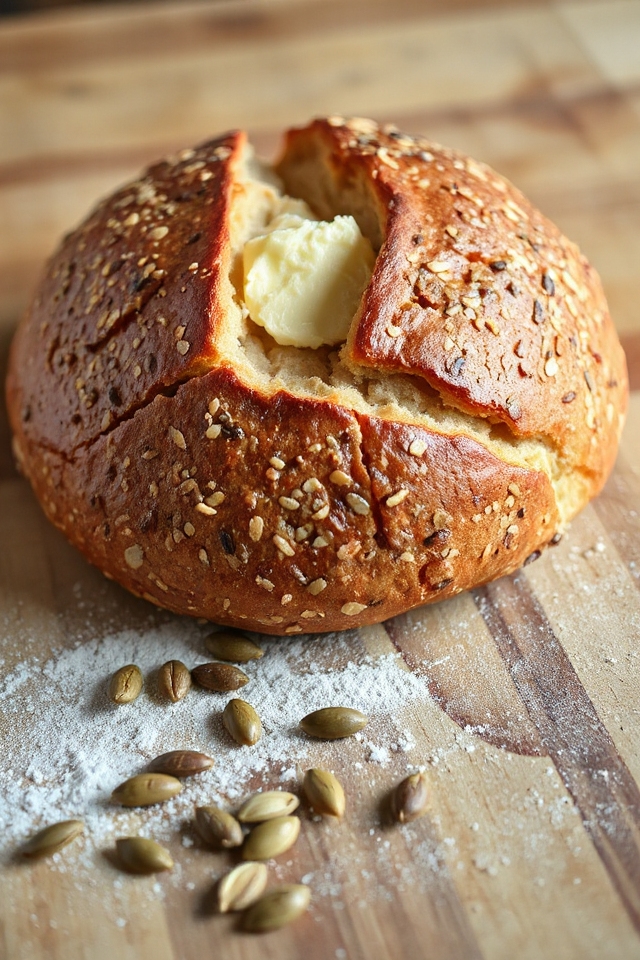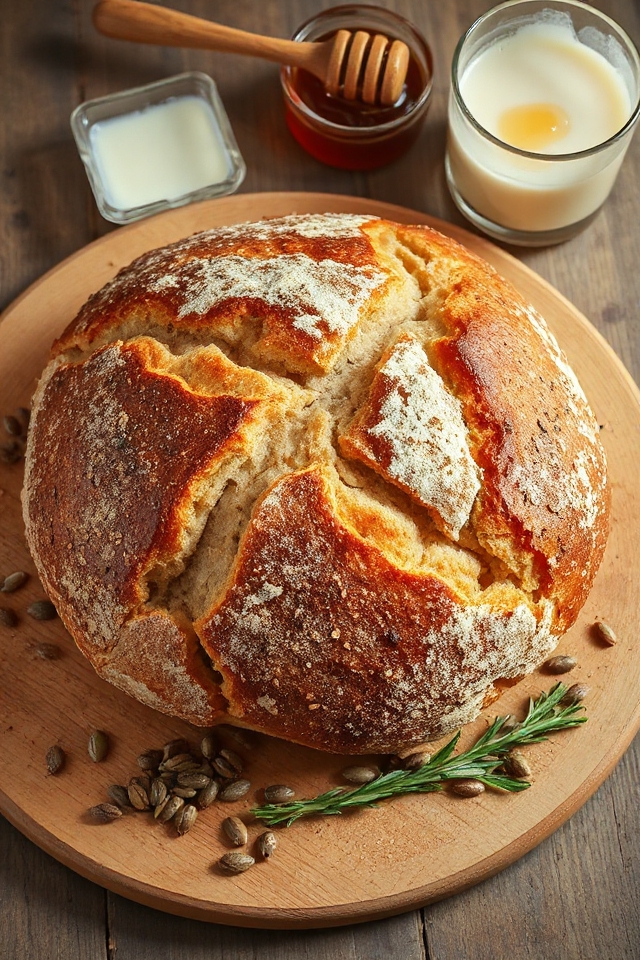Why You’ll Love This Multigrain Sourdough Bread Recipe
When you take your first bite of this multigrain sourdough bread, you’ll understand why it’s become a favorite in my kitchen. The crust is perfectly crisp, while the inside is soft and chewy, making each slice a delight.
The nutty flavors from the grains blend beautifully with the tang of sourdough, creating a taste experience that’s simply irresistible. I love how versatile it is, whether I’m slathering it with butter or using it for sandwiches.
Plus, the aroma wafting through my home as it bakes is enough to make anyone’s mouth water. You’ll definitely want to make this again!
Ingredients of Multigrain Sourdough Bread
Making multigrain sourdough bread is a delightful adventure in the kitchen, and the ingredients are what make this bread truly special. They come together to create a loaf that’s not just delicious but also nourishing.
If you’re a fan of a bit of crunch and a whole lot of flavor, you’re going to love this recipe. Let’s explore what you need to whip up this amazing multigrain sourdough bread.
Ingredients:
- 2 cups proofed sourdough starter
- 2 tablespoons butter or 2 tablespoons olive oil
- 1/2 cup milk
- 1 teaspoon salt
- 1/4 cup honey
- 1/2 cup sunflower seeds
- 1/2 cup amaranth or 1/2 cup quinoa
- 3 1/2 cups multi-grain flour (I use Robin Hood Best for Multigrain)
Now, let’s chat a bit about these ingredients. The sourdough starter is the star of the show, giving the bread that signature tangy flavor.
If you haven’t proofed your starter yet, don’t worry; it’s a simple process. Just mix equal parts of flour and lukewarm water into your starter and let it sit overnight. The longer you let it proof, the more sour flavor you’ll get, which is fantastic if you like a stronger taste.
And as for the grains, feel free to mix and match! If you can’t find amaranth or quinoa, other grains can bring their unique twist to the mix. Just be sure to keep that multigrain essence alive.
How to Make Multigrain Sourdough Bread

Making multigrain sourdough bread is a fantastic way to reveal your inner baker, and trust me, it’s easier than you might think. First off, start with 2 cups of proofed sourdough starter. If you’ve been nurturing your starter, it’s time to let it shine. Just toss it into the bread machine pan as the first step.
Then, add in 2 tablespoons of butter or olive oil—whichever you fancy. I usually go for olive oil because it adds a lovely richness without the heaviness. Next, pour in 1/2 cup of milk. This ingredient might seem minor, but it really helps create that soft, tender crumb we all love. Sprinkle in 1 teaspoon of salt for flavor, and then follow it up with 1/4 cup of honey. Oh, the honey is a game-changer—it brings a subtle sweetness that pairs beautifully with the tang of the sourdough.
Now, we’re not done yet. It’s time for the crunchy goodness: add 1/2 cup of sunflower seeds and either 1/2 cup of amaranth or quinoa. You can really get creative here; if you have other grains lying around, go ahead and throw those in. Finally, add 3 1/2 cups of multi-grain flour. I’m a big fan of Robin Hood Best for Multigrain, but use what you have.
After you’ve tossed everything into the pan, close it up, set your machine to the dough cycle, and let the magic happen.
Once the dough cycle is done, the fun really begins. Take that beautifully risen dough out and gently plop it onto a lightly floured surface. Now comes the shaping part, which can feel a bit intimidating but is so rewarding. Whether you form it into a loaf for a pan or shape it into a round loaf for a more rustic look, just remember to be gentle.
Place it in a greased loaf pan or on a cornmeal-coated cookie sheet. Now, cover it and let it rise. Patience is key here; it can take several hours, especially because sourdough is on its own special schedule. When it’s puffed up and peeking over the edges, preheat your oven to 375 degrees F.
Bake it for about 40 to 50 minutes until it’s golden brown and makes a hollow sound when tapped. If you want to indulge a little, brush the top with butter for that irresistible soft crust. Once it’s done, let it cool on a wire rack.
And then, the moment of truth—slice into it and enjoy the fruits of your labor. You did it!
Multigrain Sourdough Bread Substitutions & Variations
While experimenting with multigrain sourdough bread, I love discovering various substitutions and variations to suit my taste and pantry.
For instance, if I’m out of honey, maple syrup works just as well. I often swap in different seeds like chia or flax for added texture. If I crave a nuttier flavor, I sometimes incorporate chopped walnuts or almonds.
When I want a gluten-free option, I use a gluten-free flour blend instead of multi-grain flour. Additionally, adding herbs or spices like rosemary or cinnamon can elevate the flavor profile.
The possibilities are endless, and it’s all about personal preference!
Additional Tips & Notes
Experimenting with substitutions can lead to delightful surprises in your multigrain sourdough bread. I’ve found that adding different seeds or nuts can enhance flavor and texture.
If you want a sweeter loaf, try incorporating dried fruits like cranberries or raisins. Remember, the hydration level can vary, so adjust the liquid if you switch flours.
If you’re short on time, a warm spot can speed up rising. Ultimately, don’t rush the baking; it’s essential for developing that crusty exterior.
Trust your instincts, and you’ll create a bread that’s uniquely yours! Enjoy the process and the delicious results!
